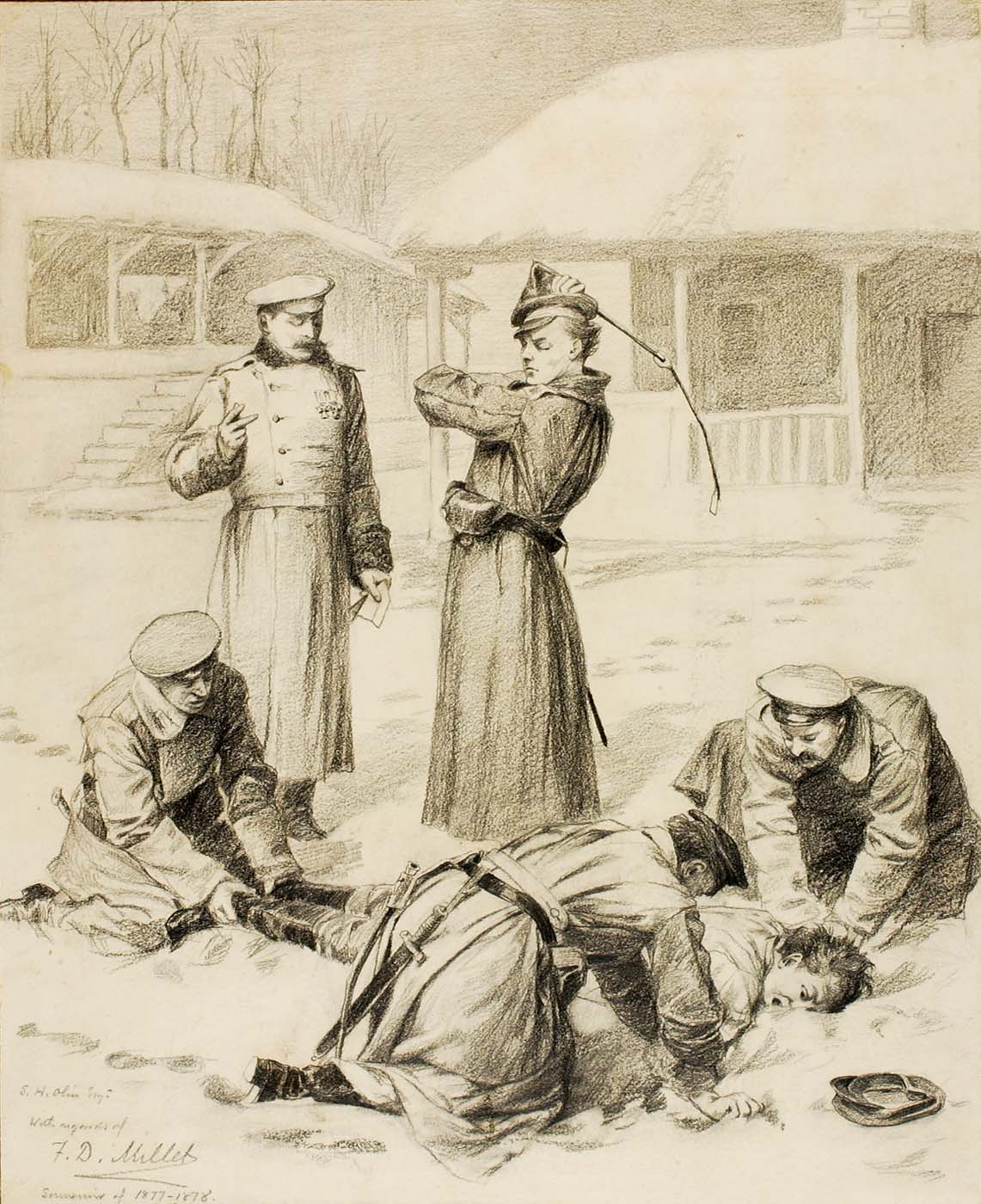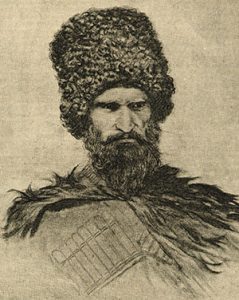

1887, Cossack Illustrations
Title: 50 Lashes Title: Cossacks Raiding a Village
Date: 1887
Dimensions: Illustrations
Medium: Graphite and Ink
Owner/Location: Harper’s Magazine, Through the Caucasus, part II, May 1887. Part I was run April 1887.
Description
Millet was a lifelong journalist, author, and artist. Often illustrating his own news stories or feature articles. He wrote for the best newspapers in both Boston, and New York, as well as leading European newspapers and periodicals. However, one of his most favorite publications was the wildly popular Harper’s Weekly, then monthly Magazine. Harper’s both commissioned articles from Millet and they had him illustrate other authors stories. In addition, to short form writing, Millet published several books and translated Tolstoy’s Sebastopol.
As a journalist/illustrator, Millet could often be found in the middle of the “action.” One such assignment was as a war correspondent during the 1887-1888 Russian-Turkish was as it was called. By the end of the war, Millet had been honored with medals for bravery by both the Russian and Romanian governments. (See Maynard’s portrait of Millet at this time on the website home page) Despite coming out of the war unscathed, he was often in sticky situations and at times he was called upon to save men’s lives conducting emergency field surgery, which he had learned assisting his father a surgeon during the US Civil War. All of this direct involvement in his stories brought a realism to his reports and illustrations that made his work widely appreciated by the reading audience.
The two illustrations that head this section by Millet are dated 1887 and may depict Millet’s actual war experiences during that time. Some scholars have suggested the 50 lashes sketch could actually have been Millet himself being held down, because he was “found” in enemy territory. Either way, it depicts the harsh treatment by the Russians either in the Balkans, the Caucasus, or Turkey, all of which boarder the Black Sea which Russia wanted to control. Millet effectively captures the readers attention with the illustrations and we read to get the rest of the story.
This illustration below and several others shown in the Gallery are from this Russian war period. Each piece of art draws the reader intimately into the action and the lives of the people shown, even if it is a “simple” portrait. We see through their faces the deeper meaning of the “story.”
The Circassian shown here may be a soldier himself, but he is certainly a patriot of his people. The Circassians (also referred to as Cherkess or Adyghe; Adyghe and Kabardian: Адыгэхэр, romanized: Adıgəxər) are an indigenous Northwest Caucasian ethnic group and nation native to the historical country-region of Circassia in the North Caucasus. Geographically located in on the northeastern edge of the Black Sea. As a consequence of the Circassian genocide, which was perpetrated by the Russian Empire in the 19th century during the Russo-Circassian War. The invasion of Circassia by Russia, started in 1763 with the Russian Empire assuming authority in Circassia by military force and ending 101 years later with the last army of Circassia defeated on 21 May 1864. Most Circassians were exiled from their homeland in Circassia to modern-day Turkey and the rest of the Middle East, where the majority of them are concentrated today. Most of the Circassians are Muslim.
Circassians should not be confused with Cossacks. The Cossack homeland roughly laid east to west above, north, of both the Caucasus and the Balkans, in what would be roughly present day Ukraine. Ethnic Russians would often use Cossacks to attack the the two regions to their south, surrounding the Black Sea and Russia had a great desire to control the Black Sea ports and coastline.

Circassians associate the Cossacks, from the north, with the bloody conquest of their homeland by Russia since the 1700s, when Cossacks often spearheaded Russian advances in the Caucasus region. The Russian government highly prized the Black Sea coast, deeming it strategically important. After the tsarist government took control of the northwestern Caucasus, it expelled nearly the entire Circassian population from the region southward into Turkey.
The Russian Turkish war (1887-1888) is a later war than the Russian Caucasus war which began in the 1700’s and ended officially in the early 1800’s, however the suppression of the Caucasus region continued on into the 1880s The Russian -Turkish war (1887-1888) was fought primarily in the Balkans, running from the edge of the Adriatic Sea, east to the Black Sea. The war spilled over into the Caucasus region which ran from the eastern Balkan border east around the northern edge of the Black Sea. Since the 1600s Russia has coveted the Black Sea ports and the1887-1888 war originated because of the emerging 19th century Balkan nationalism which was embraced by the Circassian people who had endured 200 years of Russian domination.
Additional factors motivated the Russian Balkan/Turkish war. For example, the Russian’s had a goal of recovering territorial losses endured during the Crimean War of 1853–56 with western powers, re-establishing itself in the Black Sea and supporting the political movement attempting to “free Balkan nations” from the Ottoman Empire.
The Russian-led coalition won the 1887-1888 war, pushing the Ottomans back all the way to the gates of Constantinople, Turkey, leading to the intervention of the western European powers, again, who were afraid of renewed Russian domination of the entire region, thus creating an uneasy balance of eastern and western power in the region with Russia gaining some Black Sea ports and Turkey controlling the southern Black Sea ports.
https://www.refworld.org/docid/55e8651f4.html
https://www.britannica.com/topic/Circassian
Exhibitions / Provenance
Exhibitions:
Provenance:
Literature
Research:
Publications:
